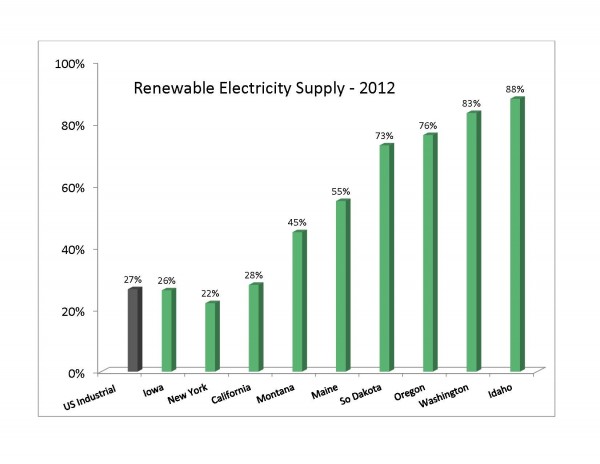Past experiences with doubling renewable energy in the U.S. show that three of the president’s largest proposals can deliver reductions in carbon emissions. Great lessons learned so far light the path for reaching and exceeding the president’s goal for doubling again our deployment of renewable energy.
The president’s climate action plan directs the federal government to obtain 20 percent of its electricity from renewable sources by 2020.
 This post is part of a series on President Obama’s Climate Action Plan.
This post is part of a series on President Obama’s Climate Action Plan.
What we know: Renewable electricity standards (RES) use market mechanisms to gradually increase the amount of renewable energy in a state’s power supplies. They have been adopted by 29 states and the District of Columbia and are working effectively. Seventeen of these states have targets of 20 percent or greater. These state RES laws have pushed non-hydro renewables to now supply more than 5 percent of the total U.S. power supply, up from less than 2 percent in 2007. Eighteen states plus D.C. have five years or more operating experience with these policies.
Already many states have more than 20 percent renewable energy. Some Midwest states produce more than 20 percent of their electricity from wind; others combine wind, biomass, geothermal, hydropower, and solar.

Lessons learned, from forecasting the natural patterns of the energy availability to using the advantages of the technology, will allow the entire U.S. grid to use 20 percent or more renewable energy. Studies by power system operators and national labs show 20 percent or more wind and solar on the grid is clearly feasible on a large scale, both economically and technically. These studies have been made and revisited steadily since 2007. Practical changes in power system operations are tested and deployed steadily across the country as the renewables arrive. Implementing this part of the President’s plan with new wind and solar plants should be no problem.
The president’s plan directs the Environmental Protection Agency (EPA) to limit carbon from existing power plants, providing states with flexibility and taking advantage of a range of energy sources

Lessons learned so far light the path for reaching and exceeding the president’s goal for doubling our deployment of renewable energy. Photo: Lizzie Wells
What we know: The EPA can and should allow states flexibility in how this standard is met, and new renewable energy can be a great solution. In addition to the states’ leadership on renewable energy standards, the states’ experience in the past implementing acid rain limits show the way forward. Others can better describe how to design carbon standards. See our blog to understand that path.
When the states implement the new carbon standard for existing power plants, they may choose to use renewable energy and energy efficiency as the means. If all the states do this, the labs and industry have tools and direction on how the U.S. can operate with 80 percent of electricity from renewable energy.
Much of what we will need to do to make the grid reliable at such high levels of renewables is already known. The new practices, the new ways of thinking, and the additional planning that have started with the state renewables standards make possible this path for implementing the EPA’s carbon limits on existing power plants with plenty of new renewable energy.
The president’s plan includes the Department of Defense hosting 3 gigawatts of renewable energy production at existing military bases
What we know: The Defense Department has ample plans, room, and a running start on leasing and contracting for renewable energy on bases. One lesson that can and should be included to make these on-base energy facilities more valuable is to tie them electrically to the base operations so the energy can be used in an emergency when the grid is down.
It does not strike me as funny to think that most of our military base facilities and personnel in the U.S. will have the same trouble with power failures that you and I experience. Making wind, solar, and geothermal plants located on U.S. military bases capable of operating during a blackout will cost more. Added reliability usually costs more. But if we are preparing for impacts of climate change, and we want to have our national defense assets available for disaster relief, we should take the time and expense to make the power plants on military bases capable of serving the military bases when the need is the greatest. The local utilities can be part of this solution, as El Paso Electric has done.
In sum, it looks to us like the president’s climate plan can do more for renewable energy, and renewable energy can do more for the climate. Now we need the rest of the policy reforms, from aligning utility incentives and tax credits to support renewable energy all the way through to the elimination of fossil fuel subsidies. The rules for the marketplace, and the price of carbon pollution, will make all the difference in mobilizing private sector investment to meet this challenge.
